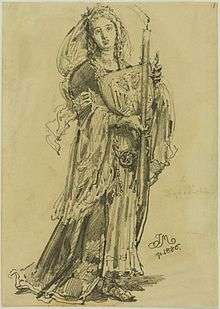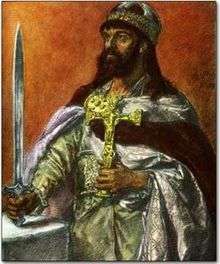Christianization of Poland
The Christianisation of Poland[1] (Polish: chrystianizacja Polski)[2] refers to the introduction and subsequent spread of Christianity in Poland.[3] The impetus to the process was the Baptism of Poland (Polish: chrzest Polski), the personal baptism of Mieszko I, the first ruler of the Polish state, and much of his court. The ceremony took place on the Holy Saturday of 14 April 966, although the exact location is still disputed by historians, with the cities of Poznań and Gniezno being the most likely sites. Mieszko's wife, Dobrawa of Bohemia is often credited as a major influence on Mieszko's decision to accept Christianity.
While the spread of Christianity in Poland took centuries to finish, the process was ultimately successful, as within several decades Poland joined the rank of established European states recognised by the papacy and the Holy Roman Empire. According to some historians the baptism of Poland marks the beginning of Polish statehood.[4] Nevertheless, the Christianisation was a long and arduous process, as most of the Polish population remained pagan until the Pagan Reaction during the 1030s.
Background

Before the adoption of Christianity, Poland was a pagan country. Svetovid was among the most widespread pagan gods worshiped in Poland. Christianity arrived on the Polish lands around the late 9th century, most likely around the time when the Vistulan tribe encountered the Christian rite in dealings with their neighbors, the Great Moravia (Bohemian) state. Although some of the Great Moravian Christian rites and faith might have spread to the Polish lands soon afterward, there is little conclusive evidence for that.[5][6]
Nonetheless, the Moravian cultural influence played a significant role in the spread of Christianity onto the Polish lands and the subsequent adoption of that religion.[1][5] In fact, the Christianisation of Poland through the Czech–Polish alliance represented a conscious choice on the part of Polish rulers to ally themselves with the Czech state rather than the German one.[1][7] In a similar fashion, some of the later political struggles involved the Polish Church refusing to subordinate itself to the German hierarchy and instead being directly subordinate to the Vatican.[6][8][9]
Baptism

The baptism of Poland refers to the ceremony when the first ruler of the Polish state, Mieszko I and much of his court, converted to the Christian religion.[5][8] Mieszko's wife Dobrawa of Bohemia, a zealous Christian, played a significant role in promoting Christianity in Poland, and might have had significant influence on converting Mieszko himself.[1][6]
The exact place of Mieszko's baptism is disputed; historians, however, argue that Gniezno or Poznań are the most likely sites.[6][10] Some historians have suggested less likely alternative locations, such as Ostrów Lednicki, or even in German Regensburg.[10] The date of Mieszko's baptism was on the Holy Saturday of 14 April 966.[6]
The ceremony was preceded by a week of oral catechism and several days of fasting. The actual ceremony involved pouring water over the segregated groups of men and women, although it is possible that their heads were immersed instead, and anointed with the chrism.[6]
Christianisation of Poland
The baptismal mission which began in the two major cities of Gniezno and Poznań with the baptism of Mieszko and his court spread throughout the country.[6] During the 10th and 11th centuries various ecclesiastical organs were established in Poland.[3][5] This included the building of churches and the appointment of clergy.[3][6] The first Bishop of Poland, Jordan, was appointed by Pope John XIII in 968.[6] Mieszko's son Bolesław I Chrobry supported Christianisation missions to neighboring lands, notably the mission of future Saint Adalbert of Prague to Old Prussians, and established the Archbishopric of Gniezno in the year 1000.[8]
Although at first the Christian religion was "unpopular and alien", Mieszko's baptism was highly influential[3] but needed to be enforced by the state, and ran into some popular opposition, including an uprising in the 1030s (particularly intense in the years of 1035–1037).[5][9] Nonetheless, by that time Poland had won recognition as a proper European state, both from the papacy and from the Holy Roman Empire.[11]
Out of various Polish provinces, Christianity's spread was slowest in Pomerania, where it gained a significant following only around the 12th century.[5] Initially, the clergy came from the Western Christian European countries; native Polish clergy took three or four generations to emerge, and were supported by the monasteries and friars that grew increasingly common in the 12th century.[3] By the 13th century Roman Catholicism had become the dominant religion throughout Poland.[3]
In adopting Christianity as the state religion, Mieszko sought to achieve several personal goals.[5] He saw Poland's baptism as a way of strengthening his hold on power, as well as using it as a unifying force for the Polish people.[5][8] It replaced several smaller cults with a single, central one, clearly associated with the royal court.[6] It would also improve the position and respectability of the Polish state on the international, European scene.[6][8] The Church also helped to strengthen the monarch's authority, and brought to Poland much experience with regard to state administration. Thus, the Church organisation supported the state, and in return, bishops received important government titles (in the later era, they were members of the Senate of Poland).[5]
Millennial celebrations of 1966
The preparations for the millennial celebrations begun with the Great Novena of 1957, which marked a nine years period of fast and prayer. In 1966, the People's Republic of Poland witnessed large festivities on the 1,000-year anniversary of those events, with the Church celebrating the 1,000 years of Christianity in Poland, while the Communist government celebrated the secular 1,000 years of the Polish State, culminated in twice denying Pope Paul VI permission to visit Poland that year. The Communist state's desire to separate religion from the state made the festivities a culture clash between the state and the Church. While the Church was focusing on the religious, ecclesiastical aspects of the baptism, with slogans (in Latin) like Sacrum Poloniae Millenium (Poland's Sacred Millennium) the Communist Party was framing the celebrations as a secular, political anniversary of the creation of the Polish state, with slogans (in Polish) like Tysiąclecie Państwa Polskiego (A Thousand Years of the Polish State). As Norman Davies noted, both the Church and the Party had "rival, and mutually exclusive, interpretations of [Poland's baptism] significance."[12]
On 30 July 1966, the U.S. Bureau of Engraving and Printing issued 128,475,000 commemorative stamps honoring the millennium anniversary of the adoption of Christianity in Poland.[13]
See also
- Christianization of Bohemia
- Christianization of Kievan Rus'
- Dagome Iudex
- History of Poland (966–1385)
- List of archbishops of Gniezno and primates of Poland
- Northern Crusades
Notes
- 1 2 3 4 Halina Lerski (30 January 1996). Historical Dictionary of Poland, 966–1945. ABC-CLIO. pp. 104–105. ISBN 978-0-313-03456-5. Retrieved 5 April 2012.
- ↑ Chrystianizacja Polski południowej. Materiały sesji naukowej odbytej 29 czerwca 1993 roku, Kraków, 1994
- 1 2 3 4 5 6 Jerzy Lukowski; W. H. Zawadzki (6 July 2006). A Concise History of Poland. Cambridge University Press. pp. 9–10. ISBN 978-0-521-85332-3. Retrieved 5 April 2012.
- ↑ Geneviève Zubrzycki (15 September 2006). The Crosses of Auschwitz: Nationalism And Religion in Post-communist Poland. University of Chicago Press. p. 64. ISBN 978-0-226-99304-1. Retrieved 5 April 2012.
- 1 2 3 4 5 6 7 8 9 Juliusz Bardach, Boguslaw Lesnodorski, and Michal Pietrzak, Historia panstwa i prawa polskiego Warsaw: Paristwowe Wydawnictwo Naukowe, 1987, pp.53–54
- 1 2 3 4 5 6 7 8 9 10 11 Jerzy Kłoczowski (14 September 2000). A History of Polish Christianity. Cambridge University Press. pp. 10–13. ISBN 978-0-521-36429-4. Retrieved 5 April 2012.
- ↑ Norman Davies (30 March 2005). God's Playground: The origins to 1795. Columbia University Press. p. 53. ISBN 978-0-231-12817-9. Retrieved 5 April 2012.
- 1 2 3 4 5 Halina Lerski (30 January 1996). Historical Dictionary of Poland, 966–1945. ABC-CLIO. p. 27. ISBN 978-0-313-03456-5. Retrieved 5 April 2012.
- 1 2 Norman Davies (30 March 2005). God's Playground: The origins to 1795. Columbia University Press. p. 57. ISBN 978-0-231-12817-9. Retrieved 5 April 2012.
- 1 2 Leszek Moczulski (2007). Narodziny Międzymorza: ukształtowanie ojczyzn, powstanie państw oraz układy geopolityczne wschodniej części Europy w późnej starożytności i we wczesnym średniowieczu. Bellona. p. 638. GGKEY:KQL3CPL831C. Retrieved 5 April 2012.
- ↑ Professor Anita J. Prazmowska (13 July 2011). A History of Poland. Palgrave Macmillan. p. 24. ISBN 978-0-230-34537-9. Retrieved 5 April 2012.
- ↑ Norman Davies (30 March 2005). God's Playground: The origins to 1795. Columbia University Press. pp. 15–17. ISBN 978-0-231-12817-9. Retrieved 5 April 2012.
- ↑ U.S. #1313 Polish Millennium MNH Archived 14 April 2015 at the Wayback Machine.
